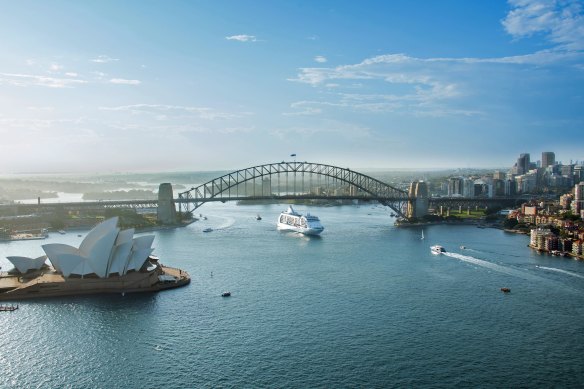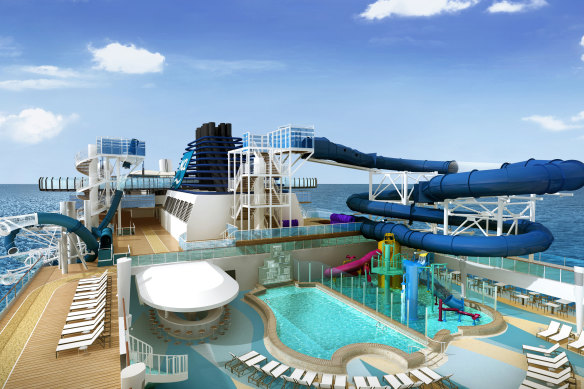How is the cruise industry doing post-pandemic? Quite nicely, thank you
Wondering how the cruise industry is doing almost two years on from the resumption of mainstream cruising in our region? The answer is: quite nicely.
According to data released by Cruise Lines International Association, 1.25 million cruises were taken in 2023.

Regent Seven Seas Voyager in Sydney Harbour.
The number slightly surpasses 2019 pre-pandemic levels, when 1.24 million Australians took to the seas. It is, however, still under the all-time high of 1.35 million achieved in 2018.
Australians resumed cruises at a faster pace than any other market, which is maybe not surprising considering our long international border shutdown, the general enthusiasm of Australians for travel, and our relative insouciance compared with travellers from some other nations.
Nevertheless, the United States remains the biggest cruise market by far, followed by Germany and the United Kingdom. Australia is a handsome fourth, despite representing only 0.33 per cent of the world’s population.
A disproportionate number of Aussie cruise passengers (57.7 per cent) hail from New South Wales, followed at a great distance by Queenslanders. Victorians are third with just 10.9 per cent of the total: half the number of Queenslanders, despite a bigger state population.
Australians are showing a marked preference for staying at home or close to it. Nearly 85 per cent of us chose to cruise in Australia, New Zealand or the South Pacific, a rise of over 10 per cent from 2019.
The next most popular destination is the Mediterranean at just 5.3 per cent, followed by Asia, Alaska and Northern Europe.
Worldwide, the news is even more impressive. According to CLIA, 31.7 million people hopped aboard an ocean cruise in 2023, which is a record. The optimism is reflected in new cruise ship orders. Eleven new cruise ships will launch this year, 18 next year, and 12 are on the order books for 2026.
Norwegian Cruise Line Holdings (which owns Norwegian, Oceania and Regent Seven Seas), announced its biggest ship-build program ever earlier this year. In the decade up to 2036, it intends to launch eight vessels across the three brands.
Other big players Carnival Corporation, MSC and Royal Caribbean Group also have multiple ships on order, signalling optimism for future cruise demand.

Norwegian Cruise Lines ship, Norwegian Encore – the line plans to add eight more cruise ships to its fleet.
Of course, the cruise industry constantly sails stormy seas. Geopolitical instability, which has already altered cruise-ship schedules in the Red Sea, appears to be increasing. An economic downturn would be a blow, and soaring fuel costs affect the cruise industry’s bottom line.
Fuel costs might be tempered by new fuel-efficient ships and technologies, and might also hasten retirement for some older ships. But the environmental impact of cruising remains in the spotlight, and cruising may well become an increasing target of protesters.
On the other hand, cruising has a relatively low market penetration of well under 10 per cent, with abundant opportunity to lure more travellers onto ships. In addition, rapidly growing middle-class markets in China, India, Vietnam, Brazil and elsewhere offer big opportunities. Watch this space.
EVERYONE ASKS
Why are ships referred to as female?
There is no clear reason why ships should be referred to as “she” but, since ancient times, ships have been associated with goddesses, female water sprites and mother figures, perhaps because these are considered safe, protective and nurturing.
That theory doesn’t work with hurricanes and cyclones, however, which were traditionally given female names (by international convention, they now alternate from female to male). Also, it was once thought bad luck to have a woman on board a sailing ship.
Some say the habit is because the Latin “navis” is grammatically feminine, but this isn’t convincing either, considering the French derivative “navire” (and others in Romance languages) is masculine. In any case, the English word “ship” comes from the German “schiff”, which carries a neutral article.
In English, ships began to be commonly referred to as “she” in the 17th century. The habit has faded in recent times. The most prominent register of shipping, Lloyd’s, began referring to ships as “it” in 2002.
Cruise ships often have female-sounding names or are named after prominent women. Perhaps cruise companies feel these carry associations of elegance and grace. Expedition ships apparently require more rugged connotations and might be named – especially by European companies – after male explorers such as Roald Amundsen and Jacques Cartier.
Sign up for the Traveller Deals newsletter
Get exclusive travel deals delivered straight to your inbox. Sign up now.